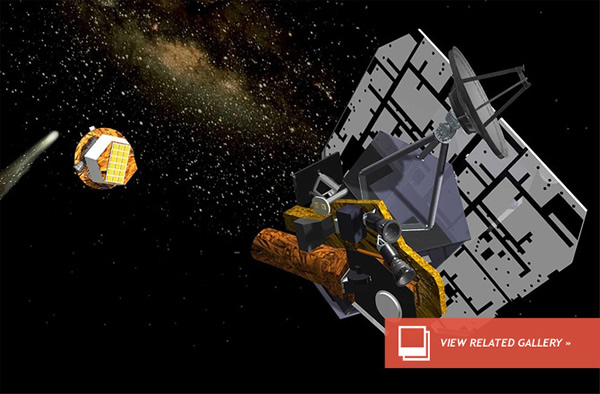In a Spin? NASA Loses Contact with Comet Chaser
In a Spin? NASA Loses Contact with Comet Chaser
A veteran NASA comet-chasing probe has stopped communicating with mission managers and is apparently spinning out of control.
The robotic spacecraft, that was sent to Comet Tempel 1 to carry out a historic bombing run with a washing machine-sized 370 kilogram (820 lb) impactor on July 4, 2005, was originally called Deep Impact, but had its mission extended to continue solar system exploration after its cometary encounter and renamed Extrasolar Planet Observation and Deep Impact Extended Investigation, or EPOXI. Scientists of the University of Maryland manages the EPOXI mission.
After the 2005 comet encounter, EPOXI completed an Earth flyby and was sent to travel past another icy body, Comet Hartley 2, in 2010, recovering high resolution images of the comet’s nucleus. The mission was then tasked with another, more distant, observation of Comet Garradd in 2012. Most recently, the spacecraft was commanded to track the incoming Comet ISON, recovering the first images in January. In 2008, a component of the EPOXI mission (called the Extrasolar Planet Observation and Characterization, or EPOCh) was also used to characterize observations of previously discovered extrasolar planets orbiting other stars.
But it seems that the EPOXI mission may have come to an end.
In a mission update on Sept. 3, EPOXI lead scientist Michael A’Hearn said, “We have not received any of our expected observations of comet ISON due to a spacecraft problem. Communication with the spacecraft was lost some time between August 11 and August 14 (we only talk to the spacecraft about once per week). The last communication was on August 8. After considerable effort, the team on August 30 determined the cause of the problem. The team is now trying to determine how best to try to recover communication.”
According to a Nature News blog report on Sept. 5, A’Hearn added that his team were unable to upload commands to EPOXI to switch it into a safe mode. The probe is now thought to be spinning out of control, severely impacting its ability to generate energy through its solar array. Although engineers have identified the problem as being a computer glitch and are working to revive the mission, it is thought the probe only has a matter of days until its batteries are drained. Once that happens, the spacecraft will be unrecoverable.
“How long we have depends on the state the spacecraft is in, and we don’t yet know that,” A’Hearn told SPACE.com on Monday (Sept. 9). “Could be that it is too late already — could be we have another month or more.”
Image: Artist’s impression of NASA’s Deep Impact sending its impactor toward Comet Tempel 1 in 2005. Credit: NASA(Sep 10, 2013 12:09 PM ET // by Ian O'Neill)












